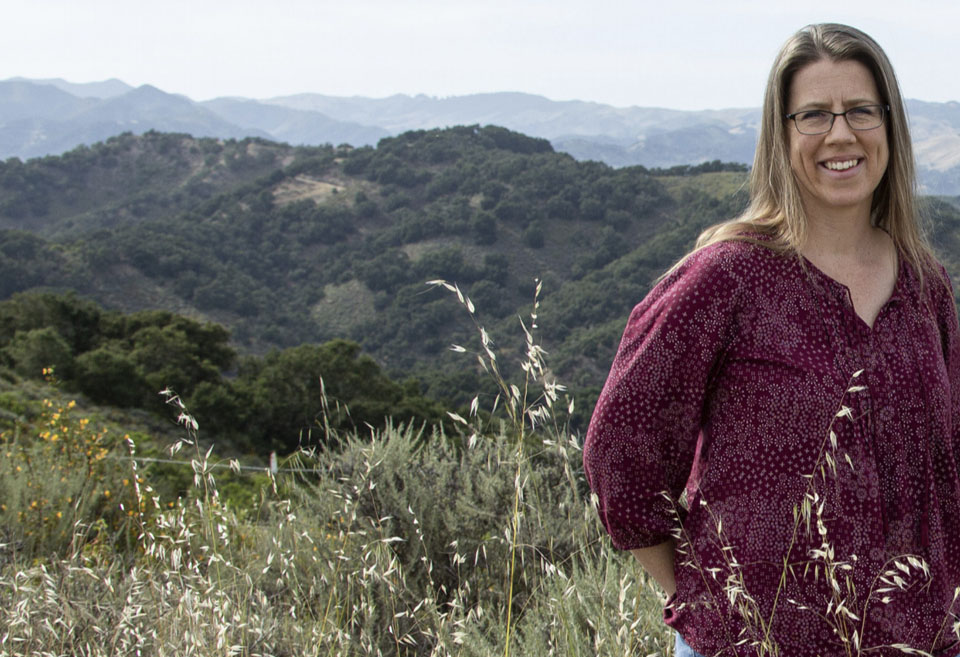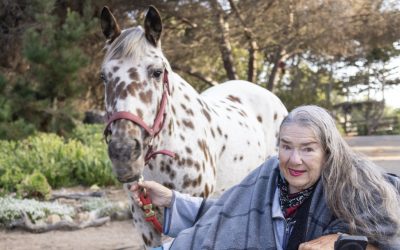During a hike at Eagle Ranch in South Atascadero recently, a pair of the ranch’s namesake raptors circled overhead as if on cue for our group of trekkers to admire. Around us, beautiful oaks of many varieties, miles and miles of sprawling grassy fields, incredible views of the hills far beyond and the occasional cow competed with our attention as we navigated bumpy trails, gopher holes and muddy trenches—and, of course, the occasional oversized cow patty. The four-mile hike sponsored by The Land Conservancy of San Luis Obispo County offered a rare opportunity for a small docent-led party to intimately experience one of the organization’s latest protected properties.
A few hours later, dusty, dry and only a little tired after an uphill elevation equal to 51 stories (according to a tracking app), we were left with a greater appreciation of the rugged beauty that many of us drive right by every day (it can be seen from 101 near Santa Barbara Road exit, look to the left going north)—and thankfully, one that will be protected in perpetuity, or at least the 3,255 acres protected by The Land Conservancy.
While one would think that the idea of “land conservancy” is in and of itself a noble cause; the truth is The Land Conservancy’s mission and projects range far beyond not only preserving donated/purchased properties to remain in their natural condition, but also achieving major goals of Conserving, Caring and Connecting to ensure a greater benefit to the community, agriculture, wildlife and more—including local cities’ coffers. Executive Director Kaila Dettman also pointed out that the local independent nonprofit is a major player in the area’s thriving tourism industry. “Eco Tourism is very real,” she said. “Our sites are popular for visitors and hoteliers; the quality of life brings business.”
Hikers, outdoor enthusiasts and nature lovers come from near and far to experience such remarkable projects as Kathleen’s Canyon Overlook “A Park For All To Enjoy,” in Arroyo Grande, the nearly-completed Pismo Preserve and nine “open-to-the-public” hiking trails (shown online) that encompass the entire county. In addition, 14 properties can be accessed through docent-led hikes through on-line sign-ups. The remainder of The Land Conservancy’s projects are either private (not available to the public) or underway.
“Our projects connect people with nature and at the same time offer so much more to our community,” Dettman said recently. “The scenic views, wildlife habitat and endangered native plant protection projects, and helping landowners keep their farms and ranches together are among our mission’s efforts to maintain our agricultural way of life, clean air and clean water and wildlife populations.” And, it turns out; the benefit extends to us, too. “The smiles on people’s faces after they’ve come off a mountain or a trail reinforce our belief that the land heals people,” she said. “Being out in nature is good for our well-being and that really motivates us to let people know what we’re up to and that it’s important to get outside!”
Dettman explained the concept of conservation easements: a tool used to offer tax breaks to landowners wishing to keep their property under its natural state, including agriculture or cultivation but are not subject to development. That’s a simplistic description, however.
“Every site is different,” Dettman emphasized, describing how The Land Conservancy came to acquire the Eagle Ranch easement as an example. “It was about a 12-year project, working with the Smith family to secure an agreement,” she said. Dettman, who has worked for The Land Conservancy for 14 years, said the Eagle Ranch discussions began prior to becoming Executive Director in 2012; indicating how long projects can take (some only take a few years too). “It starts with the property owner approaching us to walk a path together; we only work with willing sellers who wish to preserve their property but are amenable to relinquishing certain rights such as, in this case, cutting down trees extensively, developing the property and exporting water.” In return, again in this case, the landowners are able to use the land for agriculture purposes and realize tax benefits, she explained. “Of course it’s more complicated than that but typically after years of negotiations, both their goals and ours are realized,” she added.
Another tour recently enjoyed by some board members and guests was The Pereira Octagon Barn on lower Higuera Street in SLO that boasts a long and interesting place in the county’s history. Italian-Swiss immigrant Antonio Stornetta who leased the facility for his Santa Fe Dairy operation first used the barn, built in 1906; later the Pereira and Garcia families operated the Home Dairy there and made daily milk deliveries throughout the city. When small-scale dairies no longer proved economically viable in the 1950s, it became a cow-calf operation for a few more decades until its sale to John and Howard Hayashi in 1994 The barn’s unique design and landmark as “gateway to San Luis Obispo” are visible from Highway 101.*
Styled after typical 1800s Midwest barns, the 5,000 sq. ft. structure was near ruin by the mid 1990s and scheduled to be demolished when “It was saved by accident,” said board member emeritus BK Richard. “Someone at the County said ‘You shouldn’t do that, call the Land Conservancy’ after reviewing the application and realizing it was a historic and iconic structure.” Later the Barn was registered on the National Registry of Historic Places.”
It took The Land Conservancy 10 years to save the structure and retrofit it for earthquake compliance, and another 10 years to bring it up to usability—and raise the nearly $7 million the renovation and center creation would take. Meanwhile, partnerships have formed with Caltrans and the County of San Luis Obispo to provide facilities including parking, restrooms and a trailhead hub connecting to the Bob Jones Trail.
The Barn will be available in 2020 for events such as weddings, birthdays, fundraisers, etc. Other outbuildings include a dairy barn known as the “Milking Parlor,” now converted and available as a meeting space for smaller events and museum displays, the future Bob Jones trailhead amenity area, known as the “calf barn” and the “shed” a building that will support the operation of the new Center. “This project will provide a major point of tourism,” Richard said. “People can park here and ride their bikes to Avila Beach and also enjoy the facility. It will be a lot of things to a lot of people.” While the project has come a long way, its completion is anticipated within a year and The Land Conservancy will be taking reservations for the meeting space starting July 2019 for the 2020 calendar year. And, says Richard, “Our fundraising efforts continue. We still need to raise about $800,000 more.” The Land Conservancy welcomes donations, offers memberships and volunteer opportunities toward this end.
On the Eagle Ranch hike, I proved a “leisurely” hiker behind the others, taking in the sights and marveling at the idea this property will always enjoy protected status as, according to UC Agriculture and Natural Resources data, “By 2040, in California alone, 5 million acres of farmland and open space will be lost to urban development.”
At that moment I recalled a conversation from the past in the 1970s when a visiting friend hiked with me at Montana de Oro. Waving her arm across the expanse of Morro Bay and beyond she said, “You are so lucky to live here. I saved up all year to come and visit you! I hope when I retire I can live here too.” Her words reminded me of how grateful I am to live—and hike—here and that generations to come will be able to do the same thanks to the efforts of The Land Conservancy.
Want to know more? View a photo gallery of projects and programs and learn about the amazing children’s program “Learning Among the Oaks,” Academic Internships, Volunteer Days and docent opportunities. Visit www.LCSLO.org for information.
Just out of curiosity… Why an octagon-shaped barn?
BK Richard explained that there are competing theories about why an octagon styled barn might have been desirable for dairy farmers. In the 1800s, round or round-shaped (8-, 10- or 12-sided) barns were fairly common in the Midwest, though in California they were relatively late coming on the scene and only a small number were built—and of those, very few remain. One school of thought is that the shape provided more space using fewer materials. According to information obtained online, the Kansas State Board of Agriculture estimated a 34 percent to 58 percent savings in cost compared to a rectangular barn while also providing more open space for farmers to work without having to dodge support posts and feed stored in the center made it easier to distribute to the wedge-shaped stalls around the inside. Another theory is that a ship captain, Henri LaFranchi, who liked to build unusual things, built the barn. Come see the barn and judge for yourself!
On Pacific Time.
Always open.
Email or call
805-466-2585
Loving Life on the
Central Coast, California
On Pacific time.
Always open.
Email or call
805-466-2585





